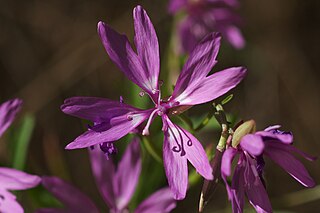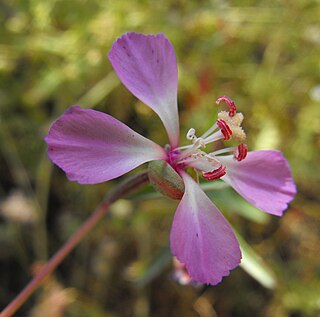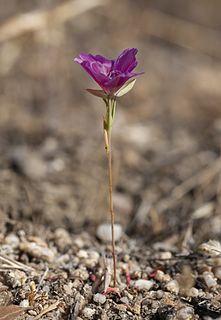
Clarkia davyi is a species of flowering plant in the evening primrose family known by the common name Davy's fairyfan, or Davy's clarkia. It is endemic to California, where it grows in coastal habitats such as beaches and bluffs. This is an annual herb producing a thin stem which grows along the ground or somewhat upright. It is lined with small oval-shaped leaves one or two centimeters long. While in bud the flower is enclosed in four fused thick sepals. It blooms into a petite bowl-shaped corolla of four pink petals which often have lighter bases. Each petal is 5 to 11 millimeters long.

Clarkia cylindrica is a species of flowering plant in the evening primrose family known by the common name speckled fairyfan, or speckled clarkia.
Clarkia australis is a species of flowering plant in the evening primrose family known by the common name Small's southern clarkia. It is endemic to California, where it grows in the forests of the central Sierra Nevada. It is an uncommon species threatened by such forest activities as logging. This annual herb produces a slender, erect stem approaching a meter in height. The leaves are widely linear in shape and borne on short petioles. The top of the stem is occupied by the tall inflorescence, which bears hanging buds that open from the lowest upward so that there are several closed buds above open flowers. The sepals do not remain fused as the flower opens. The petals are diamond-shaped and sometimes lobed and curling at the tip. They are mottled or spotted lavender, purple, and reddish in color, and each is up to 1.5 centimeters long. There are 8 long stamens tipped with large anthers bearing blue-gray pollen. The stigma protrudes past the anthers.

Clarkia biloba is a species of flowering plant in the evening primrose family known by the common name twolobe clarkia and two lobed clarkia.
Clarkia borealis is a rare species of flowering plant in the evening primrose family known by the common name northern clarkia. It is endemic to California, where it is known from the forests of the southern Klamath Range and the southernmost Cascade Range foothills. It is an annual herb growing an erect, slender stem. The leaves are oval in shape and borne on short petioles. The top of the stem is occupied by the inflorescence, in which the lowest flowers open first and hanging, pointed flower buds occur at nodes at the top. The sepals separate as the flower blooms, revealing purplish pink petals. Each petal is between 1 and two centimeters long, elongated triangular to semicircular in shape, and sometimes flecked with dark purple. There are 8 stamens with anthers bearing blue-gray pollen, and a protruding stigma.

Clarkia delicata is a rare species of flowering plant in the evening primrose family known by the common names Campo clarkia and delicate clarkia. It is native to northern Baja California and adjacent San Diego County, California, where it grows in the woodland and chaparral of the Peninsular Ranges. This is an annual herb producing an erect stem just over half a meter in maximum height. The leaves are oval or widely lance-shaped, up to 4 centimeters long, and borne on very short petioles. The top of the stem is occupied by the inflorescence, in which the lower flowers open while the upper buds hang closed. The sepals remain fused as the flower blooms from one side. Each unlobed oval petal is about a centimeter long and pink to pinkish-lavender. There are 8 stamens, some with large orange anthers and some with smaller, paler anthers. There is also a protruding stigma with four large, fuzzy lobes.

Clarkia exilis is a small herbaceous annual plant of western North America. It is an uncommon species in the evening primrose family known by the common names Kern River clarkia and slender clarkia.

Clarkia franciscana is a rare species of flowering plant in the evening primrose family known by the common name Presidio clarkia. It is endemic to the San Francisco Bay Area of California, where it is known only from two populations at the Presidio of San Francisco and three occurrences in Oakland. The plant is known only from serpentine soils.
Clarkia heterandra is a species of flowering plant in the evening primrose family known by the common name mountain clarkia. It is endemic to California, where it is from the forests and woodlands of several of eastern and western mountain ranges. It is an annual herb producing an erect, glandular stem to around half a meter in maximum height. The lance-shaped to oval leaves are up to 8 centimeters long and are borne on petioles of up to 2 centimeters. The top of the stem is occupied by the inflorescence, with open flowers and closed buds. The sepals remain fused as the flower blooms from one side. The pink petals are oval in shape and just a few millimeters long. There are 8 stamens, some large and some small and sterile. The fruit is a small, hard body 2 or 3 millimeters long containing 1 or 2 seeds.

Clarkia imbricata is a rare species of flowering plant in the evening primrose family known by the common name Vine Hill clarkia. It is endemic to Sonoma County, California, where it is known from only one remaining natural occurrence near Vine Hill. A second natural population located on private land was extirpated when the owners plowed up the soil crust. The California Native Plant Society has established a third population from cuttings and is tending it in a reserve. This is a federally listed endangered species.

Clarkia jolonensis is an uncommon species of flowering plant in the evening primrose family known by the common name Jolon clarkia. It is endemic to Monterey County, California, where it is known from the woodlands of the Central Coast Ranges.
Clarkia lewisii is an uncommon species of flowering plant in the evening primrose family known by the common name Lewis' clarkia. It is endemic to California, where it is known from the hills and mountains of Monterey and San Benito Counties. It is an erect annual herb generally under half a meter in height. The lance-shaped leaves are a few centimeters long. The inflorescence bears opening flowers and closed, hanging flower buds. As the bud opens the pink or purple sepals stay fused as the petals bloom from one side. The fan-shaped petals are up to 3 centimeters long, pink to lavender with white and red coloration near the bases. There are 8 stamens and a protruding stigma.

Clarkia modesta is a species of flowering plant in the evening primrose family known by the common name Waltham Creek clarkia. It is endemic to California, where it is known from the woodlands of several of the central mountain ranges, including the North and Central Coast Ranges and the Sierra Nevada foothills. It is an erect annual herb often exceeding half a meter in height. The oval, linear, or lance-shaped leaves are 2 to 4 centimeters long. The inflorescence bears opening flowers and closed, hanging flower buds. The sepals remain fused as the petals bloom from one side. The petals are about a centimeter long and vary in shape from diamond to widely lance-shaped. They are pale to deep pink and generally dark-flecked or spotted.

Clarkia mosquinii is a rare species of flowering plant in the evening primrose family known by the common name Mosquin's clarkia. It is endemic to California, where it is known only from the northern Sierra Nevada foothills at the border between Butte and Plumas Counties. It was thought to be extinct until it was rediscovered in 1991. It is an erect annual herb often exceeding half a meter in height. The oval or lance-shaped leaves are 2 to 5 centimeters long. The inflorescence bears opening flowers below a series of clusters of closed, hanging flower buds. The sepals all separate as the flower blooms. The diamond-shaped petals are one to two centimeters long light to medium purple in color, and sometimes speckled with reddish purple.
Clarkia prostrata is a species of flowering plant in the evening primrose family known by the common name prostrate clarkia. It is endemic to the coastline of San Luis Obispo County, California, where it grows on seaside bluffs in forested and grassy areas. This annual herb is prostrate as opposed to erect as most other Clarkia species are. Its stems extend to a maximum length approaching half a meter and are usually somewhat fuzzy in texture. The leaves are oval in shape, up to 2.5 centimeters long, and lack petioles. The sepals of the flower separate into two pairs, revealing the lavender-pink blooming petals. Each petal is just over a centimeter long, fan-shaped to oval, and sometimes with a yellow base marked with a red spot.

Clarkia speciosa is a species of flowering plant in the evening primrose family known by the common name redspot clarkia. It is endemic to California, where it is known from the Central Coast and mountains and from the Sierra Nevada foothills. The plant is variable across its intergrading subspecies, taking a decumbent to erect form with a stem up to about half a meter long. The open or dense inflorescence has opening flowers and several closed buds. As the bud opens the sepals all separate from each other. The fan-shaped petals are up to 2.5 centimeters long and may be lavender to pink to deep red, sometimes fading to white or yellowish at the base. There is sometimes, but not always, a large bright red spot near the middle of the petal.
Clarkia tembloriensis is a rare species of flowering plant in the evening primrose family, known by the common name Temblor Range clarkia and belonging to the Onagraceae family.

Clarkia virgata is a species of flowering plant in the evening primrose family known by the common name Sierra clarkia. It is endemic to California, where it is known from the forests and woodlands of the Sierra Nevada.

Clarkia williamsonii is a species of flowering plant endemic to California, where it is known from the forests and woodlands of the northern and central Sierra Nevada foothills.

Clarkia xantiana is a species of flowering plant in the evening primrose family known by the common name gunsight clarkia. It is endemic to California, where it is known from the southern Sierra Nevada and its foothills and the adjacent Transverse Ranges. This is an erect annual herb with linear to lance-shaped leaves each up to 6 centimeters long. The inflorescence produces opening flowers and closed buds. The sepals stay fused as the petals bloom from one side. Each petal is up to 2 centimeters long and generally light to medium purple in color, sometimes with a dark, ringed spot on the petals of the upper whorl. The petal has a narrow claw and a wider blade which has two lobes at the tip with a small tooth between.















